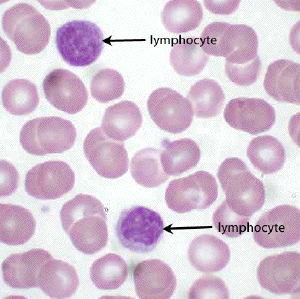Slide DMS #101 [Blood Smear, human, Wright stain]. Examine the slide first under low power and then under high power. Note: this slide was scanned at 100X (oil imersion). Identification of cells should be attempted only in areas where the red blood cells are but one layer deep and the nucleus and cytoplasm of the white cells are undistorted and well-stained. Try to identify the following:
1. Red blood cells (RBCs, erythrocytes)

2. White blood cells (WBCs, leukocytes):
A. neutrophils (polymorphonuclear leukocyte, "polys") eosinophils

B. monocytes

C. lymphocytes

D. basophils (rare)

3. Platelets
As you study the various kinds of white blood cells, compare them in size to the surrounding red blood cells. Normal, undistorted, adult human red blood cells will be in the 7-8 µm diameter range. (In histological sections of paraffin embedded tissues the diameter of RBCs is in the range of 6-7 µm due to shrinkage artifact), Which type of white blood cell is the largest? Which is the smallest? The primary criteria for identifying the various kinds of white blood cells are: 1) the size of the cell, 2) the size and shape of the nucleus and the distribution of chromatin within it, and 3) the amount of cytoplasm and the number and staining reactions of the granules present within it. Note: Basophils, while not difficult to identify, are relatively rare in the normal blood smear. If you cannot find one in your slide, or are having trouble deciding whether or not a particular cell is a basophil, see the demonstration slide of this cell type.
After you are satisfied with your ability to identify the various kinds of white blood cells, compare the relative abudance of the leukocytes in your smear to the expected differential values that you, of course, have already committed to memory. Abnormally high or low percentages of white blood cell types often accompany and are diagnostic of many diseases.
In practice, a search should be made for any abnormalities in the leukocytes, including such things as hyperlobulation and hypergranulation of the neutrophils, inclusion bodies, abnormal lymphocytes, immature cells, etc.
In addition, one should note any abnormalities of the erythrocytes. A greater than four-fold variation in size of the erythrocytes should be noted as it is the hallmark of megaloblastic anemia. A significant variation in shape of the erythrocytes, spherocytic changes, stippling and other anomalies should also be noted. When the area of central pallor occupies more than two-thirds of the cell and the remaining rim of hemoglobin fades gradually into the area of pallor (a sharp line of demarcation is due to artifact) hypochromia may be diagnosed. You will become acquainted with these and other less frequent abnormalities of erythrocytes when you study hematology.
What is a rouleaux formation? What is the appearance of a crenated red blood cell? Finally, the number of platelets per oil immersion field should be noted. When successive fields contain fewer than four platelets and they are not present elsewhere on the slide in clumps, the platelets are said to be decreased.
One should develop his/her own system of examining a smear to determine systematically whether any pathological changes are present. Unless this is done, the presence of spherocytes, absence of platelets, etc., will be overlooked.Use the highest magnification to examine this smear of peripheral blood. Count 100-200 white blood cells to do a "differential", and compare with data in the lab manual. Scattered among the red blood corpsucles (erythrocytes) are numerous white blood cells (leukocytes). Identify neutrophils, eosinophils, lymphocytes, and monocytes. Basophils are more difficult to find. Note also, clumps of thrombocytes (platelets). Which kinds of white cells are most numerous in blood? Why are they called "white cells"? Read about their characteristics and functions. Be able to recognize each type of blood cell in electron micrographs from your text and atlas.
Note: another commonly used name for neutrophil is polymorphonuclear leukocyte, or polymorph (or PMN for short). What is there about the shape of the cell's nucleus that makes this a reasonable name?
Another Note: The fluid plasma surrounding blood cells is important to their well being. What effect would you expect the hypertonicity or hypotonicity of the surrounding medium would have upon erythrocytes? What is meant by crenation? Hemolysis? What care must be taken when blood is withdrawn for laboratory examination?